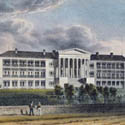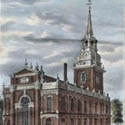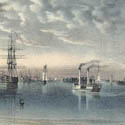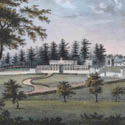Lithography
Invented at the close of the 18th century, lithography differed from earlier printing processes in that the image that was being printed was on the same level as the printing plate, rather than raised from or inscribed into it; and the printing plate was usually a thick slab of limestone, highly polished, rather than a piece of copper or wood.
The lithographic process is based on the simple principle that oil and water do not mix. The design was drawn on the stone with oily crayon or ink, the stone was dampened all over, and then printing ink was rolled over it. Wherever there were oily lines, the printing ink adhered; while in the areas of smooth, unmarked stone, the water repelled the ink.
Wild's Views of Philadelphia
J.C. Wild’s 1838 Views of Philadelphia was Birch updated for a new generation: most of the buildings he depicted had been built since 1800, and the small-format, delicately colored lithographs were more suited to the respectable middle-class city that had grown up in place of the national capital depicted in heroic terms by Birch. Whereas Birch’s views were too expensive for the Library Company’s collection, Wild’s apparently were too cheap and ephemeral. They were sold for 25 cents a pair as part of a newspaper promotion.
Like Birch’s views, they did not join the collection until they had become historical documents. The first copy accessioned was an 1848 reissue, bequeathed in 1866 by local historian Charles Poulson. The plates displayed here were mostly cut out and mounted by antiquarian John A. McAllister, who bequeathed his enormous collection of printed and graphic ephemera in 1884.
|
|
U.S. Naval Asylum |
Christ Church |
|
|
|
|
Philadelphia, from the
Navy Yard |
Laurel Hill Cemetery |
NEXT >



